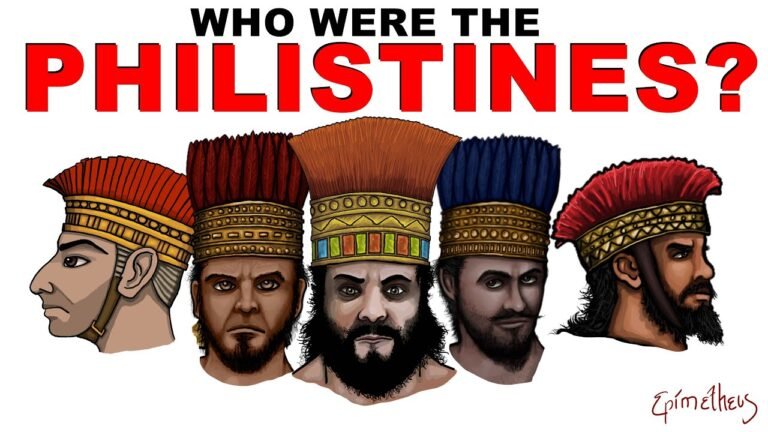Unveiling the Philistines: A Historical Overview
The Philistines, an enigmatic and influential group of ancient people, played a pivotal role in the history of the Near East during the Iron Age. Often depicted as adversaries of the Israelites in biblical texts, the Philistines were more than just foes; they were a sophisticated society known for their distinctive culture, advanced technology, and maritime prowess. This article delves into the origins, lifestyle, and impact of the Philistines, unraveling the complexities of their civilization and their lasting legacy in the annals of history.
What ethnicity were the Philistines?
The Philistines emerged as a distinct group around 1175 BC, likely tracing their origins to the Aegean region of Greece. This period coincided with the widespread upheaval known as the Late Bronze Age collapse, which allowed for migration and settlement across the Eastern Mediterranean. As they arrived in Canaan, the Philistines brought with them their own cultural practices and social structures, setting the stage for a unique blend of influences.
In their new environment, the Philistines began to interact and assimilate with the local Canaanite populations. This exchange was not merely one-sided; the Philistines incorporated various elements of Canaanite society into their own, enriching their culture while maintaining distinct aspects of their heritage. This dynamic process of cultural integration resulted in a society that was both familiar and foreign, marked by a blend of Aegean and Canaanite traits.
As the Philistines established themselves in Canaan, their identity evolved into a complex tapestry of influences. They became known for their fortified cities and advanced technologies, which set them apart from neighboring groups. Through trade, warfare, and cultural exchange, the Philistines left a lasting impact on the region, contributing to the rich historical narrative of ancient civilizations in the Near East.
Who were the Philistines mentioned in the Bible?
The Philistines were a non-Semitic group that established themselves in the southern coastal region of Canaan, an area that came to be called Philistia. Notable figures in the Old Testament, they are frequently depicted as adversaries of the Israelites, engaging in numerous conflicts that highlight their significant role in the ancient Near East. Their interactions with the Israelites, filled with rivalry and warfare, shaped much of the historical narrative in biblical texts, leaving a lasting impact on the cultural landscape of the time.
What is the modern term for Philistines?
The Philistines, an ancient people known for their conflict with the Israelites, have long since vanished from history. Despite their notable presence in biblical narratives, the Philistines ceased to exist as a distinct group thousands of years ago, leaving behind only archaeological remnants and historical accounts.
Today, some people link the modern-day Palestinians to the Philistines due to the phonetic similarity of their names. However, this connection is largely a misconception, as the Philistines as a distinct identity have been extinct for centuries. The contemporary Palestinian identity is shaped by a complex history and diverse cultural influences that extend far beyond the ancient Philistine heritage.
Discovering the Legacy of an Ancient Civilization
The echoes of an ancient civilization resonate through the remnants of its architectural marvels, intricate artifacts, and rich cultural narratives. Each stone and relic tells a story of ingenuity, showcasing the advancements in engineering, art, and governance that defined their era. As modern explorers sift through the sands of time, they unearth not only physical evidence but also the profound wisdom and philosophies that continue to shape our understanding of humanity.
In the heart of this exploration lies the quest to decode the symbols and writings left behind by our ancestors. These inscriptions serve as a bridge connecting the past with the present, offering insights into their daily lives, beliefs, and societal structures. Scholars and archaeologists alike are piecing together these fragments, revealing a complex tapestry of customs and traditions that highlight the civilization’s values and aspirations.
As we delve deeper into the legacy of this ancient civilization, we uncover lessons that remain relevant today. Their resilience in the face of challenges, innovative spirit, and commitment to community serve as a reminder of the enduring qualities that unite us across generations. By honoring their contributions and learning from their experiences, we not only preserve their memory but also enrich our own cultural landscape for future generations.
The Rise and Fall of the Philistine Culture
The Philistine culture, once a formidable presence in the ancient Near East, thrived from the 12th to the 7th century BCE, characterized by its distinctive art, architecture, and trading prowess. As a seafaring people, the Philistines established five city-states along the coastal regions of present-day Israel and Gaza, where they engaged in vibrant trade networks and cultural exchange. However, their fortunes began to wane due to internal strife and external pressures, particularly from neighboring powers like the Israelites and Assyrians. By the end of the 7th century, the Philistine identity diminished as they faced conquest and assimilation, leaving behind a legacy that continues to intrigue historians and archaeologists alike.
Unraveling the Myths: Who Were the Philistines?
The Philistines have long been shrouded in mystery, often depicted as formidable adversaries in biblical narratives. However, recent archaeological discoveries challenge the simplistic view of them as mere antagonists. Evidence suggests that the Philistines were a complex society with a rich culture, characterized by advanced craftsmanship, distinctive pottery, and unique architectural styles. Their cities, such as Ashkelon and Gaza, were bustling centers of trade and innovation, indicating that they played a significant role in the region’s economic and cultural exchange.
Beyond their portrayal as enemies of the Israelites, the Philistines were also skilled seafarers and traders who interacted with various civilizations, including the Egyptians and the Aegeans. This cross-cultural exchange influenced their customs and lifestyles, making them more than just a monolithic group. By unraveling the myths surrounding the Philistines, we gain a deeper understanding of their contributions to ancient society, highlighting their importance in the tapestry of history rather than relegating them to the role of mere villains.
Insights into Philistine Society and Influence
The Philistines, often perceived as the antagonists of biblical narratives, possessed a complex society that thrived during the Iron Age along the coastal regions of present-day Israel and Gaza. Archaeological discoveries reveal their vibrant culture, characterized by advanced pottery, metallurgy, and urban planning. The Philistines established five prominent city-states—Gaza, Ashkelon, Ashdod, Ekron, and Gath—each functioning as a center of trade and innovation, which allowed them to maintain a robust economy and a distinct identity within the ancient world.
Religion played a pivotal role in Philistine life, influencing their social structures and daily practices. Their pantheon included deities such as Dagon, a god of agriculture and fertility, reflecting their agrarian roots. Rituals and festivals were integral to community cohesion, fostering a sense of belonging among the diverse populations within their territories. This religious framework not only guided their moral compass but also set the stage for interactions with neighboring cultures, including the Israelites, leading to both conflict and cultural exchange.
The Philistine legacy extends beyond their military confrontations and biblical portrayals, as their innovations and artistic expressions left a lasting imprint on the region. Their contributions to agriculture, architecture, and trade facilitated the spread of ideas and technologies that shaped the socio-economic landscape of the ancient Near East. By examining the Philistine society through a broader lens, we gain valuable insights into the complexities of their civilization, revealing a culture rich in creativity, resilience, and adaptability that continues to intrigue historians and archaeologists alike.
The Philistines: More Than Just Biblical Adversaries
The Philistines, often remembered as the formidable foes of ancient Israel in biblical tales, were a complex society with a rich cultural heritage that extends beyond their adversarial reputation. Originating from the Aegean region, they settled along the coastal plains of present-day Israel and Gaza, where they established vibrant city-states like Ashkelon, Gaza, and Ekron. Their unique contributions to art, technology, and trade played a significant role in shaping the ancient Near East, showcasing a civilization that thrived on innovation and cultural exchange.
Despite their portrayal as antagonists in scripture, the Philistines exhibited a sophisticated understanding of metallurgy, agriculture, and urban planning, influencing their neighbors and enhancing regional trade networks. Archaeological findings reveal intricate pottery, advanced fortifications, and evidence of a bustling economy that contradict the simplistic view of them as mere adversaries. By examining their societal structures and interactions with surrounding cultures, it becomes clear that the Philistines were a dynamic people whose legacy is woven into the rich tapestry of ancient history.
The Philistines, often shrouded in mystery, were a significant force in the ancient Near East, known for their fierce resistance against Israelite encroachment and their unique cultural contributions. Through archaeological discoveries and historical texts, we gain a clearer understanding of their society, from advanced metallurgy to their distinctive pottery. By exploring the lives and legacies of the Philistines, we not only uncover the complexities of their civilization but also enrich our comprehension of the intricate tapestry of ancient history.







